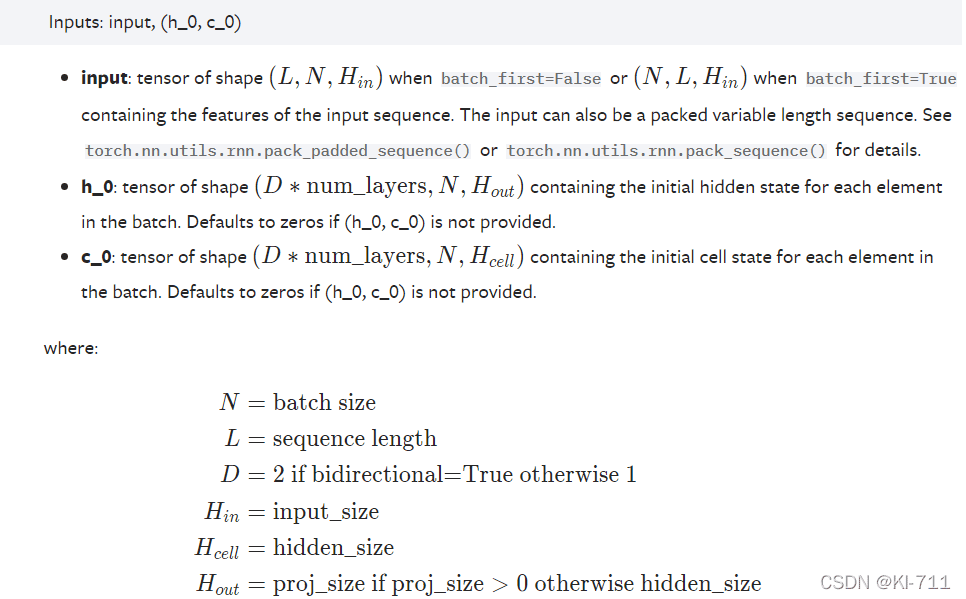PyTorch深度学习LSTM从input输入到Linear输出
作者:Cyril_KI
LSTM介绍
关于LSTM的具体原理,可以参考:
https://www.jb51.net/article/178582.htm
https://www.jb51.net/article/178423.htm
系列文章:
LSTM参数
关于nn.LSTM的参数,官方文档给出的解释为:

总共有七个参数,其中只有前三个是必须的。由于大家普遍使用PyTorch的DataLoader来形成批量数据,因此batch_first也比较重要。LSTM的两个常见的应用场景为文本处理和时序预测,因此下面对每个参数我都会从这两个方面来进行具体解释。
- input_size:在文本处理中,由于一个单词没法参与运算,因此我们得通过Word2Vec来对单词进行嵌入表示,将每一个单词表示成一个向量,此时input_size=embedding_size。
- 比如每个句子中有五个单词,每个单词用一个100维向量来表示,那么这里input_size=100;
- 在时间序列预测中,比如需要预测负荷,每一个负荷都是一个单独的值,都可以直接参与运算,因此并不需要将每一个负荷表示成一个向量,此时input_size=1。
- 但如果我们使用多变量进行预测,比如我们利用前24小时每一时刻的[负荷、风速、温度、压强、湿度、天气、节假日信息]来预测下一时刻的负荷,那么此时input_size=7。
- hidden_size:隐藏层节点个数。可以随意设置。
- num_layers:层数。nn.LSTMCell与nn.LSTM相比,num_layers默认为1。
- batch_first:默认为False,意义见后文。
Inputs
关于LSTM的输入,官方文档给出的定义为:

可以看到,输入由两部分组成:input、(初始的隐状态h_0,初始的单元状态c_0)
其中input:
input(seq_len, batch_size, input_size)
- seq_len:在文本处理中,如果一个句子有7个单词,则seq_len=7;在时间序列预测中,假设我们用前24个小时的负荷来预测下一时刻负荷,则seq_len=24。
- batch_size:一次性输入LSTM中的样本个数。在文本处理中,可以一次性输入很多个句子;在时间序列预测中,也可以一次性输入很多条数据。
- input_size:见前文。
(h_0, c_0):
h_0(num_directions * num_layers, batch_size, hidden_size) c_0(num_directions * num_layers, batch_size, hidden_size)
h_0和c_0的shape一致。
- num_directions:如果是双向LSTM,则num_directions=2;否则num_directions=1。
- num_layers:见前文。
- batch_size:见前文。
- hidden_size:见前文。
Outputs
关于LSTM的输出,官方文档给出的定义为:

可以看到,输出也由两部分组成:otput、(隐状态h_n,单元状态c_n)
其中output的shape为:
output(seq_len, batch_size, num_directions * hidden_size)
h_n和c_n的shape保持不变,参数解释见前文。
batch_first
如果在初始化LSTM时令batch_first=True,那么input和output的shape将由:
input(seq_len, batch_size, input_size) output(seq_len, batch_size, num_directions * hidden_size)
变为:
input(batch_size, seq_len, input_size) output(batch_size, seq_len, num_directions * hidden_size)
即batch_size提前。
案例
简单搭建一个LSTM如下所示:
class LSTM(nn.Module):
def __init__(self, input_size, hidden_size, num_layers, output_size, batch_size):
super().__init__()
self.input_size = input_size
self.hidden_size = hidden_size
self.num_layers = num_layers
self.output_size = output_size
self.num_directions = 1 # 单向LSTM
self.batch_size = batch_size
self.lstm = nn.LSTM(self.input_size, self.hidden_size, self.num_layers, batch_first=True)
self.linear = nn.Linear(self.hidden_size, self.output_size)
def forward(self, input_seq):
h_0 = torch.randn(self.num_directions * self.num_layers, self.batch_size, self.hidden_size).to(device)
c_0 = torch.randn(self.num_directions * self.num_layers, self.batch_size, self.hidden_size).to(device)
seq_len = input_seq.shape[1] # (5, 30)
# input(batch_size, seq_len, input_size)
input_seq = input_seq.view(self.batch_size, seq_len, 1) # (5, 30, 1)
# output(batch_size, seq_len, num_directions * hidden_size)
output, _ = self.lstm(input_seq, (h_0, c_0)) # output(5, 30, 64)
output = output.contiguous().view(self.batch_size * seq_len, self.hidden_size) # (5 * 30, 64)
pred = self.linear(output) # pred(150, 1)
pred = pred.view(self.batch_size, seq_len, -1) # (5, 30, 1)
pred = pred[:, -1, :] # (5, 1)
return pred
其中定义模型的代码为:
self.lstm = nn.LSTM(self.input_size, self.hidden_size, self.num_layers, batch_first=True) self.linear = nn.Linear(self.hidden_size, self.output_size)
我们加上具体的数字:
self.lstm = nn.LSTM(self.input_size=1, self.hidden_size=64, self.num_layers=5, batch_first=True) self.linear = nn.Linear(self.hidden_size=64, self.output_size=1)
再看前向传播:
def forward(self, input_seq):
h_0 = torch.randn(self.num_directions * self.num_layers, self.batch_size, self.hidden_size).to(device)
c_0 = torch.randn(self.num_directions * self.num_layers, self.batch_size, self.hidden_size).to(device)
seq_len = input_seq.shape[1] # (5, 30)
# input(batch_size, seq_len, input_size)
input_seq = input_seq.view(self.batch_size, seq_len, 1) # (5, 30, 1)
# output(batch_size, seq_len, num_directions * hidden_size)
output, _ = self.lstm(input_seq, (h_0, c_0)) # output(5, 30, 64)
output = output.contiguous().view(self.batch_size * seq_len, self.hidden_size) # (5 * 30, 64)
pred = self.linear(output) # (150, 1)
pred = pred.view(self.batch_size, seq_len, -1) # (5, 30, 1)
pred = pred[:, -1, :] # (5, 1)
return pred
假设用前30个预测下一个,则seq_len=30,batch_size=5,由于设置了batch_first=True,因此,输入到LSTM中的input的shape应该为:
input(batch_size, seq_len, input_size) = input(5, 30, 1)
但实际上,经过DataLoader处理后的input_seq为:
input_seq(batch_size, seq_len) = input_seq(5, 30)
(5, 30)表示一共5条数据,每条数据的维度都为30。为了匹配LSTM的输入,我们需要对input_seq的shape进行变换:
input_seq = input_seq.view(self.batch_size, seq_len, 1) # (5, 30, 1)
然后将input_seq送入LSTM:
output, _ = self.lstm(input_seq, (h_0, c_0)) # output(5, 30, 64)
根据前文,output的shape为:
output(batch_size, seq_len, num_directions * hidden_size) = output(5, 30, 64)
全连接层的定义为:
self.linear = nn.Linear(self.hidden_size=64, self.output_size=1)
因此,我们需要将output的第二维度变换为64(150, 64):
output = output.contiguous().view(self.batch_size * seq_len, self.hidden_size) # (5 * 30, 64)
然后将output送入全连接层:
pred = self.linear(output) # pred(150, 1)
得到的预测值shape为(150, 1)。我们需要将其进行还原,变成(5, 30, 1):
pred = pred.view(self.batch_size, seq_len, -1) # (5, 30, 1)
在用DataLoader处理了数据后,得到的input_seq和label的shape分别为:
input_seq(batch_size, seq_len) = input_seq(5, 30)label(batch_size, output_size) = label(5, 1)
由于输出是输入右移,我们只需要取pred第二维度(time)中的最后一个数据:
pred = pred[:, -1, :] # (5, 1)
这样,我们就得到了预测值,然后与label求loss,然后再反向更新参数即可。
时间序列预测的一个真实案例请见:PyTorch搭建LSTM实现时间序列预测(负荷预测)
以上就是PyTorch深度学习LSTM从input输入到Linear输出的详细内容,更多关于LSTM input输入Linear输出的资料请关注脚本之家其它相关文章!
